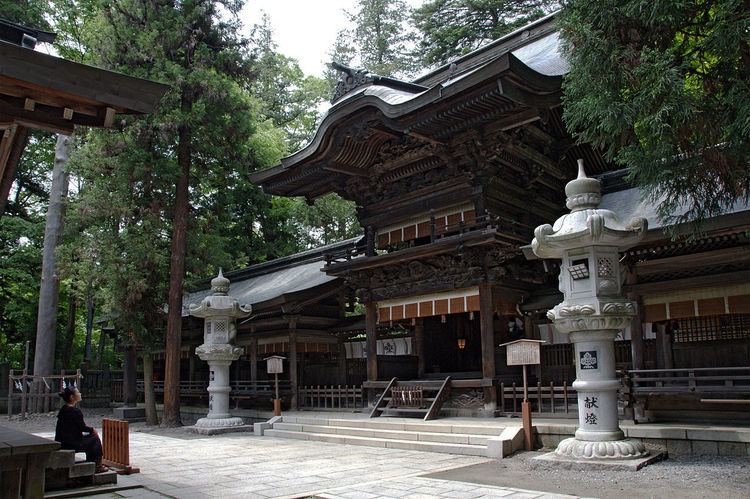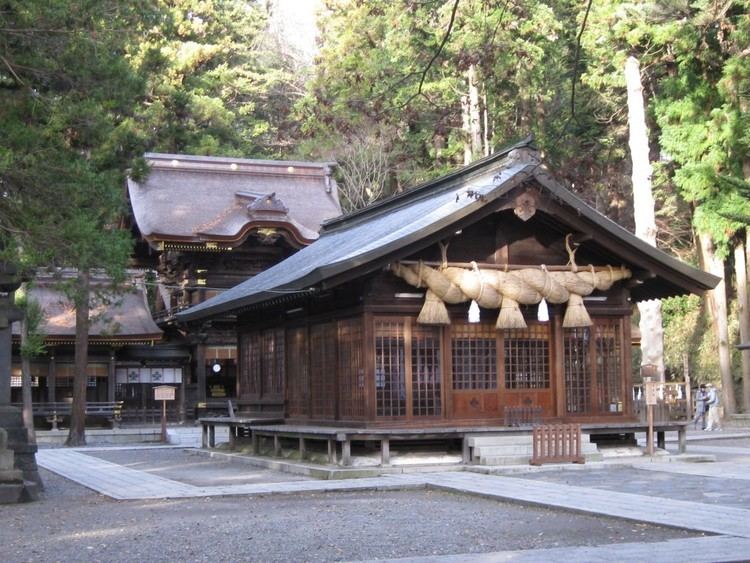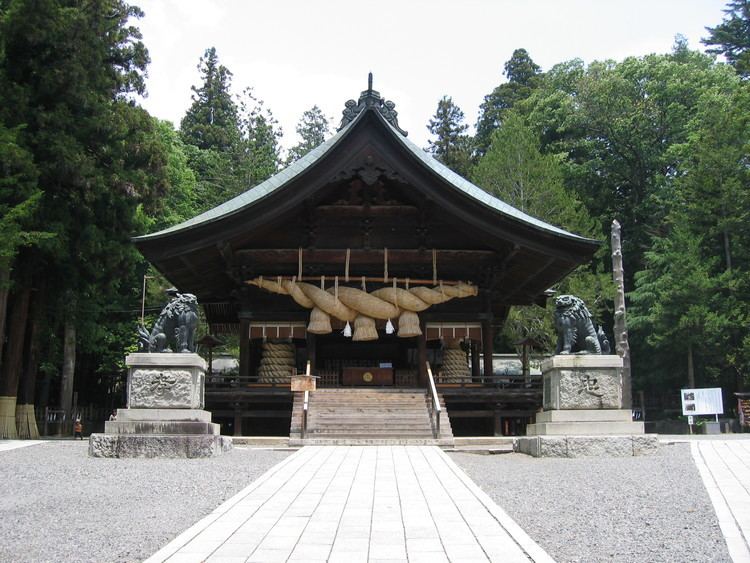Founded Unknown | Website suwataisha.or.jp | |
Dedicated to Suwa-myōjin (Takeminakata), Yasakatome Address Chino City, Nagano (Kamisha Maemiya)
Suwa City, Nagano (Kamisha Honmiya)
Shimosuwa, Nagano (Shimosha) Similar Lake Suwa, Kami‑Suwa Station, Shimo‑Suwa Station, Togakushi Shrine, Mt Moriya | ||
Suwa-taisha (諏訪大社), or Suwa Grand Shrine, historically also known as Suwa-jinja (諏訪神社) or Suwa-daimyōjin (諏訪大明神) is a Shinto shrine in Nagano Prefecture, Japan. It is considered to be one of the oldest shrines in existence, being mentioned in the Nihon Shoki as already standing in the late 7th century.
Contents
- Night walking around suwa taisha kami sha
- Deities
- In myth
- Early history
- Kamakura period
- Muromachi and Sengoku periods
- Edo period
- Meiji period onwards
- Priests
- Kamisha
- Shimosha
- Branch shrines
- Festivals
- References

The shrine consists of four building complexes grouped into two sites: the Kamisha (上社) or Upper Shrine, comprising the Maemiya (前宮 'old shrine') and the Honmiya (本宮 'main shrine'), and the Shimosha (下社) or Lower Shrine, comprising the Harumiya (春宮 'spring shrine') and the Akimiya (秋宮 'autumn shrine'). The two shrines of the Kamisha are located on the south side of Lake Suwa, in the cities of Chino and Suwa, with those of the Shimosha being situated on the northern side of the lake, in the town of Shimosuwa.

Night walking around suwa taisha kami sha
Deities

The shrine is considered to be dedicated to Suwa-myōjin (諏訪明神) and his consort. The official view is that Suwa-myōjin is the god Takeminakata recorded in the Kojiki, with his wife being the goddess Yasakatome, although some folktales also identify Suwa-myōjin with Kōga Saburō, a man who returned from a journey into the underworld to find himself transformed into a serpent or dragon. Further complicating the issue is the nature of some of the religious ceremonies of the shrine (specifically, that of the Kamisha Maemiya), in that they actually seem to feature the god(s) Mishaguji, worshipped in Suwa since time immemorial, even well before the Yamato regime extended to the region, as the main focus of worship rather than Takeminakata.
Due to the complicated history of the shrine, different conflicting opinions have been expressed as to which shrine specifically belongs to which god, with some considering Suwa-myōjin/Takeminakata to be the god of the Kamisha and his consort that of the Shimosha, others considering both deities to be enshrined at the Kamisha or the Shimosha or both, and still others including a third deity, Kotoshironushi (Takeminakata's brother), among the main gods of the shrine.

Like others among Japan's oldest shrines, three of the four main shrines of Suwa-taisha (with the exception of the Maemiya) do not have a honden, the building that normally enshrines a shrine's kami. Instead, its objects of worship or go-shintai are the mountain the shrine stands on at the Kamisha Honmiya, and a sugi (Harumiya) or yew (Akimiya) tree - 'divine trees' or shinboku (神木) - at the Shimosha.
In myth

In the Kojiki, Takeminakata, a son of Ōkuninushi, the god of Izumo, fought against Takemikazuchi, a messenger sent by the gods of heaven to claim Ōkuninushi's land in the name of the sun goddess Amaterasu. Losing against Takemikazuchi in a test of strength, Takeminakata fled to "the sea of Suwa in the province of Shinano" (科野国州羽海), where he finally agreed to surrender, promising never to leave the region.
Local myths in the Suwa region meanwhile relate that a foreign deity - Suwa-myōjin, identified with Takeminakata - once came to the area where local gods such as Moreya resisted him. After defeating them, Suwa-myōjin became the new chief god of Suwa, with Moreya serving him as his collaborator and priest.
Early history
The shrine's first historical attestation is in the Nihon Shoki, where envoys were said to have been sent to worship "the wind-gods of Tatsuta and the gods of Suwa and Minochi in Shinano" during the fifth year of the reign of Empress Jitō (691 CE). This record testifies to the worship of the god of Suwa as a water and/or wind deity during the late 7th century, on par with the wind gods of Tatsuta in Yamato Province (modern Nara Prefecture).
In Heian period documents, the shrine is mentioned in the Nihon Sandai Jitsuroku's entry for Jōgan 7 (865 CE) as 'Takeminakata-tomi-no-mikoto Shrine' (建御名方富命神社), and as 'Suwa (Shrine) of Shinano' (信乃須波) in the diary of Minamoto no Tsuneyori (976/985-1039), the Sakeiki (左経記). The 'Register of Deities' (神名帳 Jinmyōchō) section of the Engishiki (927) meanwhile lists the 'Minakatatomi Shrine(s)' (南方刀美神社) as enshrining two deities and being the two major ('eminent') shrines of Suwa district.
By the late Heian period, the shrine became designated as Shinano's chief shrine or ichinomiya. The Ryōjin Hishō, an anthology of songs compiled in 1179, names the shrine of Suwa among famous shrines to martial deities in the eastern half of the country. Another testament to Suwa-myōjin's fame as a god of war is a legend about his apparition to the 8th century general Sakanoue no Tamuramaro during his campaign to subjugate the Emishi of northeastern Japan; in thanksgiving for the god's assistance, Tamuramaro was said to have instituted the religious festivals of the shrine.
Kamakura period
The Kamakura period saw the shrine(s) of Suwa split into two entities, the Kamisha and the Shimosha. Terms such as Suwa-kamisha (諏訪上社), Suwa-jōgū (諏訪上宮), Suwa-shimosha (諏訪下社) or Suwa-gegū 諏訪下宮) begin to appear in written sources from the period such as the Azuma Kagami. Both institutions would remain technically independent of each other until the Meiji period.
During the Middle Ages, under the then-prevalent synthesis of Buddhism and Shinto, the deities of the Kamisha and the Shimosha were identified with the bodhisattvas Samantabhadra (Fugen) and Avalokiteśvara (Kannon), respectively. Buddhist temples and other edifices (most of which belonged to the esoteric Shingon school) were erected on the precincts of both shrines, including a small pagoda called the Tettō (鉄塔 "iron pagoda") - symbolizing the legendary iron tower in India where, according to Shingon tradition, Nagarjuna was said to have received esoteric teachings from Vajrasattva - and a sanctuary to Samantabhadra (普賢堂 Fugendō), both of which served at the time as the Kamisha's main objects of worship.
Buddhist ethics, which opposed the taking of life and Mahayana's strict views on vegetarianism somewhat conflicted with Suwa-myōjin's status as the patron god of hunting; elaborate theories were then devised that legitimized the hunting, eating, and sacrifice of animals such as deer, a beast held to be sacred to the god. The shrines produced special talismans (鹿食免 kajiki-men "permit to eat venison") and chopsticks (鹿食箸 kajiki-bashi) that were held to allow the bearer to eat meat.
In the meantime, devotion to Suwa-myōjin (especially as god of war) became more widespread, thanks in part to the rise in prominence of the Suwa clan - originally a priestly clan which held the office of chief priest or ōhōri of the Kamisha that later branched out into military affairs - as vassals (gokenin) of the Kamakura shogunate and the Hōjō clan. The shrines of Suwa and the priestly clans thereof flourished under the patronage of the Hōjō, which promoted devotion to the god as a sign of loyalty to the shogunate. The religious festivals of the Kamisha and the Shimosha attracted many of the samurai caste as well as other social classes, both from within Shinano and outside. Suwa branch shrines became numerous all across Japan, especially in territories held by clans devoted to the god (for instance, the Kantō region, traditional stronghold of the Minamoto (Seiwa Genji) clan).
The cult of Suwa-myōjin was also propagated by wandering preachers, the oshi (御師), who traveled around Shinano and neighboring provinces, preaching stories about the god of Suwa (i.e. the Kōga Saburō legend and other such hagiographies) and his benefits as well as distributing kajiki-men and kajiki-bashi to the populace, collecting offerings and donations in exchange. The Suwa oshi also carried with them hand bells made of iron, miniature replicas of the bells known among various names such as sanagi-suzu (佐奈伎鈴) or tettaku (鉄鐸) which were used to call forth Mishaguji in some rituals as well as seal promises and agreements in Mishaguji's name.
Muromachi and Sengoku periods
After the collapse of the Kamakura shogunate, the Suwa supported the Southern Court, while the Kanasashi clan, ōhōri of the Shimosha, chose to side with the Northern Court. This and other reasons contributed to the state of war between the Suwa and the Kanasashi, as well as other clans allied with them, during the Muromachi period. During a war between the two factions in 1483, the shrines of the Shimosha were burned down by the Kamisha's forces; its high priest, Kanasashi Okiharu (金刺興春), was killed in battle.
Around the same time, the Suwa was also involved in an intra-clan strife between the priestly (ōhōri-ke) and military branches (the main house or sōryō-ke) of the family, which ended with the sōryō-ke vanquishing the priestly branch and taking the office of ōhōri for themselves. With this (and the eventual downfall of the Kanasashi), the Suwa emerged as a regional power, coming to clash with their former allies, the Takeda of Kai Province, which eventually defeated the Suwa and conquered Shinano before the clan itself was destroyed in the aftermath of the Battle of Nagashino in 1575.
The Sengoku daimyō Takeda Shingen - ironically, the man who drove the main branch of the Suwa clan to extinction - was especially notable for his deep devotion to Suwa-myōjin. Some of Shingen's war banners bore the god's syncretized Buddhist name: Suwa-nangū hosshō-kamishimo-daimyōjin (諏方南宮法性上下大明神 'Dharma-Nature Daimyōjin of the Suwa Upper and Lower Southern Shrines'). In 1565, he also issued an order for the reinstitution of the religious rites of both the Kamisha and the Shimosha (諏方上下宮祭祀再興次第 Suwa kami-shimosha saishi saiko-no-shidai).
Edo period
During the Edo period, both the Kamisha and the Shimosha were recognized and supported by the Tokugawa shogunate and the local government. Land grants by the shogun and the local daimyō were allocated to the shrines and temples in the complex. The third Tokugawa shogun, Iemitsu, for instance, granted five villages (equals 1,000 koku) to the Kamisha and 500 to the Shimosha. The third daimyō of Suwa (aka Takashima) Domain, Suwa Tadaharu, gave the Kamisha 50 koku and the Shimosha 30 in 1663, while his successor, Tadatora, granted an additional 100 koku to the Kamisha and 60 to the Shimosha in 1695. The daimyō of Aizu and Iemitsu's brother, Hoshina Masayuki, also donated 100 koku to the Kamisha and 60 koku to the Shimosha.
The period saw escalating tensions between the priests and the shrine monks (shasō) of the Suwa complex, with increasing attempts from the priesthood to distance themselves from the temples. By the end of the Edo period, the priests, deeply influenced by Hirata Atsutane's nativist, anti-Buddhist teachings, became extremely antagonistic towards the shrine temples and their monks. In 1864 and 1867, Buddhist structures in the Shimosha were set on fire by unknown perpetrators; in the latter case, it was rumored to have been caused by the shrine's priests.
Meiji period onwards
The establishment of State Shinto after the Meiji Restoration in 1868 brought an end to the union between Shinto and Buddhism. The shrines of Suwa, due to their prominent status as ichinomiya of Shinano, were chosen as one of the primary targets for the edict of separation, which took effect swiftly and thoroughly. The shrine monks were laicized and Buddhist symbols either removed from the complex or destroyed; the shrines' Buddhist rites, such as the yearly offering of the Lotus Sutra to Suwa-myōjin (involving the placing of a copy of the sutra inside the Tettō), were discontinued. The now laicized monks at first tried to continue serving at the shrines as Shinto priests; however, due to continued discrimination from the shrine priesthood, they gave up and left.
The priests themselves were soon ousted from their offices as the state abolished hereditary succession among Shinto priests and private ownership of shrines across the country, being replaced in their duties by government appointees. A side effect of this change is that the secret tradition passed down to the jinchōkan of the Moriya clan (held to be descended from the god Moreya), one of the high priests of the Kamisha, were lost to oblivion, it being passed down via word of mouth only to the heir to the office.
By 1871, the Kamisha and the Shimosha - now under government control - were merged into a single institution, Suwa Shrine (諏訪神社 Suwa-jinja), and received the rank of kokuhei-chūsha (国幣中社), before being promoted to kanpei-chūsha (官幣中社) in 1896 and finally, to the highest rank of kanpei-taisha (官幣大社) in 1916. After World War II, the shrine was listed as a special-class shrine (別表神社 beppyō-jinja) by the Association of Shinto Shrines and renamed Suwa Grand Shrine (Suwa-taisha) in 1948.
Priests
Before the Meiji period, various local clans (many of which traced themselves to the gods of the region) served as priests of the shrine, as in other places. After hereditary priesthood was abolished, government-appointed priests took the place of these sacerdotal families.
Kamisha
These are the high priestly offices of the Kamisha and the clans which occupied said positions.
Shimosha
The following meanwhile were the high priestly offices of the Shimosha.
In addition to these were lesser priests, shrine monks (shasō), shrine maidens, other officials and shrine staff.
Branch shrines
Suwa-taisha is the head shrine of the Suwa network of shrines, composed of more than 10 thousand individual shrines.
Festivals
Suwa Taisha is the focus of the famous Onbashira festival, held every six years. The Ofune Matsuri, or boat festival, is held on August 1, and the Senza Matsuri festival is held on February 1 to ritually move the spirits between the Harumiya and Akimiya shrines.
